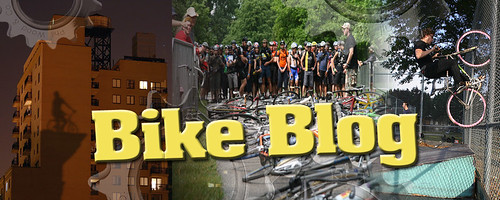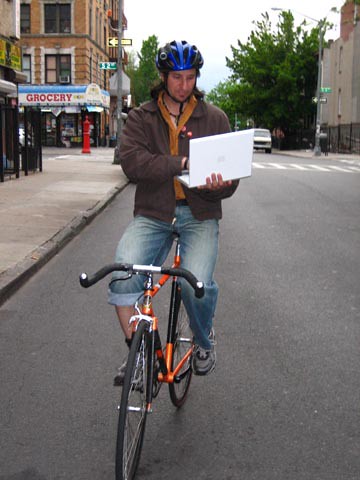How do we make our city better...look to Bogota, Colombia.
Last week he was touring NYC, giving talks and meeting with people working on sustainability to inspire them on what could be done here.
Andrea Bernstein of WNYC, conducted an interview with the former mayor who was on tour in the South Bronx with Majora Carter, director of sustainable South Bronx.
and Mark Gorton of the Open planning project conducted a 12 minute interview with Mr. Penalosa on bike tv. Rather inspiring of what can be done here.
Here is the text from the WNYC interview:
Bikes Connecting Bogota and the South Bronx
by Andrea Bernstein
NEW YORK, NY April 14, 2006 —City residents are aiming to build an 11-mile network of bikeways and parks in an unexpected place – the South Bronx. And they’re taking as their inspiration from another city you might not immediately think of – Bogota, Colombia. WNYC’s Andrea Bernstein has this report.
REPORTER: Right now, there’s not much at the future home of the Hunts Point Riverside Park on the Bronx River just above where it empties into the sound. There’s swirling dust, which quickly fills your shoes and gets underneath your clothes. But to Majora Carter, the Director of Sustainable South Bronx, this sliver of a park is a jewel.
CARTER: Cause its actually kind of pretty down here.
REPORTER: Carter got a seed grant, which she leveraged into 20 million dollars to build a park in this former junkyard, sandwiched between a recycling facility and the Hunts Point food market.
CARTER: Wow, I never noticed this before, this is new, this is really exciting, we actually have a dock, a floating dock. This was such a mess before, you cannot understand what this place used to look like.
REPORTER: The park is at the end of a spit of land that runs from the Bruckner expressway down to the food market. But it’s dense. There are 12,000 people living here. By summer, Carter hopes, some of them will be launching kayaks from this dock. For her, that’s not just a pleasant thought. Advocates of the poor used to only focus on things like housing, or schools, or jobs. And Carter thinks those things are important, too. It’s just that she sees parks as the prerequisite for all those other things to happen.
CARTER: Because you gotta make it friendlier for people to feel as though a part of a city. If you make it unfriendly for them, then no, they retreat into their homes/edit here/and you can’t build a community from inside your house, you just can’t.
REPORTER: Carter grew up here, and for her work fighting pollution she won a MacArthur “genius” grant. But reinforcement for the idea that she needed to do more came thousands of miles away – in Bogota, Colombia. She was on a tour, standing in a small plaza with a fountain running through it. And her tour guide told her a few years earlier, he would never have come to that part of town.
CARTER: Because it was so dangerous, because it was so drug infested, and now, of course, I’m coming here, and I was you know what, that is exactly what I want to hear folks in my neighborhood saying.
REPORTER: In Bogota, Carter saw dozens of miles of bikeways. Where there had been fields of mud, there were soccer fields, and playgrounds for children. Hillsides once strewn with rubble became neat stairways, with benches and flowering trees. All of this was constructed during the single three-year term of Enrique Penalosa, the former Mayor of Bogota.
PENALOSA: The only place where we really are a society, the only place where really are a society of equals, the only space that really belongs to us as a nation, is public pedestrian space.
REPORTER: In Bogota, Penalosa bucked the accepted wisdom that more highways and roads for cars would bring economic health to his city. Instead, he jettisoned a plan to build an elevated beltway around Bogota, and instead spent the money instead on paved bikeways, sports facilities, and parks. Cars drive in the mud. Since leaving office – he was term-limited out – Penalosa has been traveling the world, spreading his gospel to cities like Mexico City, Jakarta, and Dar Es Salaam. Not long ago, he met with community groups in the South Bronx.
PENALOSA: The least of the least that a democratic society should have is have is quality public pedestrian space for people at least to be able to go out and see their city. These things are not some sort of luxury, this is the beginning of compensation for the enormous inequality that there is in society.
REPORTER: Walter Hook agrees. Hook directs the Institute for Transportation and Development Policy, a group that helps third world cities install sustainable transit systems. He visited Penalosa when he was Mayor of Bogota
HOOK: What’s astonishing about this is not only has it brought down the crime rates in low income communities because the kids actually have a place to play. If you go through these neighborhoods you feel totally safe. The kids all coming running out in the street to you they all recognize Penalosa. They’re like hi, Mr. Penalosa!
REPORTER: In Bogota, Hook says, Penalosa took him on a helicopter ride to tour the bike highways, called alamedas.
HOOK: And he flies us up in the air. And he flies us up over the city of Bogota, and he goes: “There, there you see that bike lane, it’s 50 km, I built that!” He goes: “Look at that, you see that, that used to be a garbage dump, now look at it, it’s a beautiful park.” He goes “Look at this, look at these alamedas, they go 20 km into the countryside.”
REPORTER: Now there are housing and businesses along the alamedas. In Bogota now, neighborhoods for the poor are planned. And this is exactly the kind of transformation that south Bronx groups are hoping to emulate. Darting between trucks and past chop shops and waste treatment plants, members of the Southern Bronx River Watershed alliance invited Penalosa to come and visit. And they took Penalosa on a bike tour.
He critiqued their plan.
PENALOSA: I don’t think this is a very good design. CARTER: Okay, now tell me why. PENALOSA: I would not put these trees here in the middle of the sidewalk like this you know and here it needs a very physical protection for a cyclist.
REPORTER: As in most of New York City, there’s no barrier between the bike lane and traffic.
PENALOSA: Because you would not send your child along here.
REPORTER: The tour continued around Hunts points, and up to an overlook near the Sheridan expressway. The idea of reclaiming automobile space for pedestrians is an about face for the Bronx. But it’s being taken very seriously by people like Joan Byron, a planner from the Pratt Center for Communtiy Development.
BYRON: The place we’re standing right now could be the best example or it could become the worst example.
Instead, Byron and others want to tear down the Sheridan Expressway, and build affordable housing and a park going right down to the Bronx River. The state Department of Transportation has been planning a bigger interchange.
BYRON: And if the interchange is placed here it will cut people off from the waterfront even more than we really are and it will compromise and undermine everything both the city and the community have been trying to achieve.
REPORTER: Byron says the mile and a quarter expressway is little used, and is a barrier between three schools and several small baseball fields on the river. Neither the state nor the city has ruled out tearing it down.
There’s a story Enrique Penalosa likes to tell when he speaks in front of audiences, about a flock of birds on a swamp in Brazil. If the young birds learning to fly accidentally drop into the swamp, they are devoured crocodiles. He compares the herons to children in most cities today.
PENALOSA: That’s exactly the predicament our children face, they grow in terror of being killed and we have come to think that this is totally normal!
REPORTER: Creating more green space is an idea that has found a receptive ear in the Bloomberg administration. Deputy Mayor Dan Doctoroff says in poor neighborhoods like the South Bronx, it’s the city’s obligation to pay for the upkeep of parks. Doctoroff, a bike-rider himself, says he was impressed after a recent at New York City Hall with Penalosa.
DOCTOROFF: The former Mayor of Bogota, who in a very short period of time managed to achieve something that that nobody ever would have thought possible which is a dramatic improvement in the pedestrian usage of the city and I think it’s an excellent example for us.
REPORTER: Back over across the street from the future Hunts Point Riverside Park, there’s a small bakery selling cakes and rolls to a line of truck drivers passing through. But much of the time, says manager William Bonilla, its pretty dead. He’s counting on the park to liven up his business.
BONILLA: Creo que va ser bueno.
REPORTER: He says that he thinks a lot of people are going to come in the summer, because now, on the weekends they don’t have anything to do. So they’ll come to park and have a good time…and buy his cakes and coffee. This is exactly what planners like Majora Carter – and Enrique Penalosa –expect will happen. For WNYC, I’m Andrea Bernstein.











3 Comments:
Colombia, not Columbia. Sorry to be anal about that, but it's kind of a pet peeve.
You beat me to it. No U in Colombia!
How can you write an article about a country when you can't even spell it's name correctly.
Post a Comment
<< Home